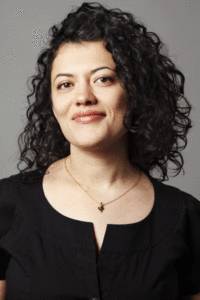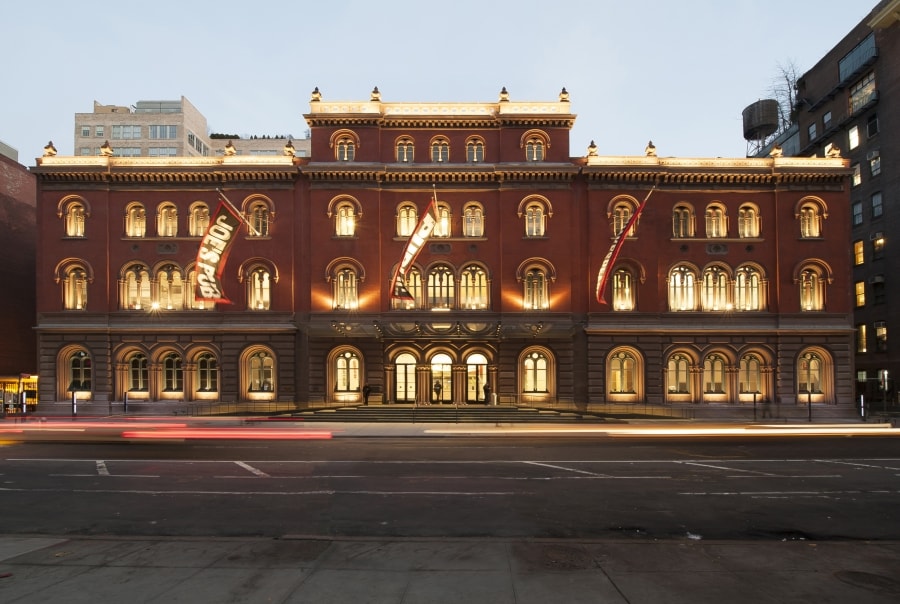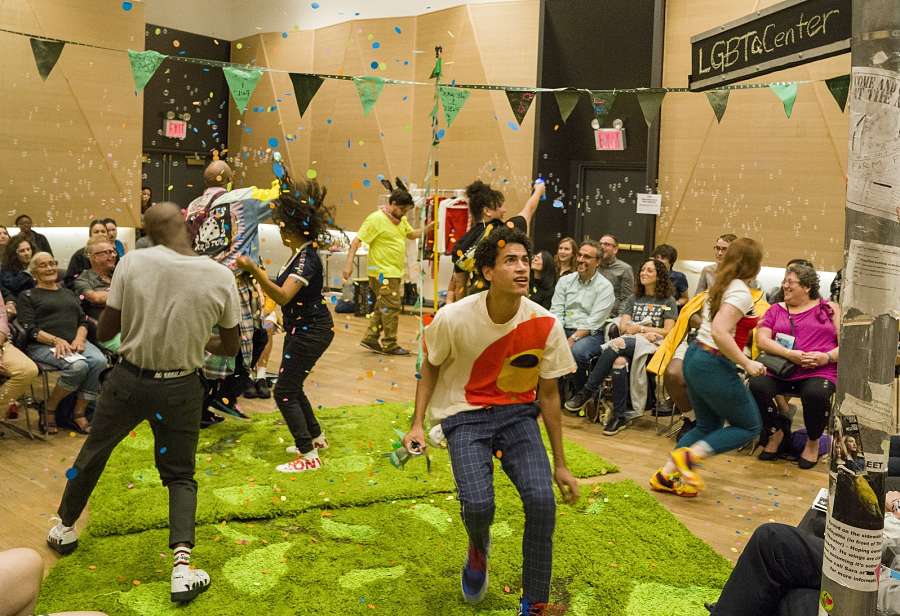In June of 2002, I moved from Indiana to New York, a city reimagining itself in real time after the events of 9/11 just nine months earlier. It had not occurred to me that this might not have been a fruitful time to join the arts scene, but I came naïve and excited to add to the possibilities. Within two weeks of arriving, I walked into the Public Theater and found myself interviewing to be an assistant in George C. Wolfe’s office. After a few short conversations, I was hired—at the stunning rate of $122 per week—and started the next day, alongside my other job serving gelato uptown.
At a time when the Public had recently laid off more than half of its staff, the scarcity embedded in the arts conversation was real, and yet every day was a joyful celebration of creation. I was the greenest of entry-level administrators, but I was welcomed as a dreamer, an artist, and a colleague. We were tasked with creating worlds, and that goal was not just for upper management or artists in the theatres surrounding our offices. I could not wait to get to work, knowing that my role was not simply to answer the phone and schedule appointments but to bring my best to every day and to participate in all the work ahead of us. This was a chance to build something new, and it would take all of us to do it. Around conference tables and rehearsal rooms, I saw folks still grappling with all the ways that a terrorist attack and the resulting economic fallout had impacted their country, their field, and their careers, and yet they made spaces where something new could be nurtured.
I have been reflecting on this time lately, perhaps unsurprisingly and perhaps through a nostalgic haze, but I know there are lessons here. This past year, I have furloughed most of my staff, I have seen friends and loved ones lose their lives to coronavirus, and I have seen my friends lose their ability to live and work in New York City, the anxiety rising as evictions loom. In December alone, my beloved church home, Middle Collegiate, burned to the ground in what has felt like an unimaginable loss, and my entire immediate family contracted COVID, bringing fear and all the accompanying anxiety. As huge parts of how I have defined my life and livelihood have shifted or disappeared completely, the shock of these events still catches me off guard.
We’re often told grief comes in waves. But the grief I’m experiencing is accompanied by something else. Amid sadness and anger, I am also buffeted by waves of profound gratitude. Gratitude for this moment to not simply pivot, but to begin again, to build a new and better country, field, and room where we can unmoor ourselves from what absolutely did not work and caused so much harm before. This current set of crises, set in its year-long frame of the COVID pandemic and its 400-year frame of systemic racism, reminds us brutally that this is a long game.

I won’t pretend it has all been a joyful act of creation, but joy must be part of the work for it to succeed. Like the Civil Rights Movement pulling from the power of sacred music rooted in Southern Black church song traditions, and the drag and fabulosity that came forward in direct response to the criminal neglect and abuse of LGBTQ+ communities during the HIV/AIDS crisis, we must now work urgently, with purpose, centered in joy. My friend and mentor, artist Toshi Reagon, reminds me that these are the tools people have repurposed in protest to remind the oppressors that they are not interested in living within the systems the oppressors have created. This is not joyful expression solely for the purpose of joy; they are the tools that work in community and can withstand great stress.
As we move through this new year and look toward who we might be as a field that not only has something to offer our communities but is also in lockstep with the healing and thriving of all people, I humbly offer my set of resolutions.
Build the room and make sure everyone is leading and participating.
In theatre, we always talk about building the room: Who is in the room? What does the room feel like? But those rooms have been shaped by clear hierarchies that will not serve us in this moment. If we are to be in service of our community, we need to start with our staff and find pathways to participation, mentorship, and transparency.
I have been in and quite honestly have helped create many rooms, rehearsal and otherwise, where the singular vision of one person is unquestionable and therefore unquestioned. These rooms are bleak and boring at best, and create nothing approximating art. In music, everyone gets a solo and is introduced by the time the concert is over, and we too must be able to celebrate our colleagues at every level. I have seen this work in rehearsal spaces. Working with performer and creator Daniel Alexander Jones in any space means the bass player has as much to offer to the dramaturgy of the piece as the prop master. Everyone is welcomed into the space, called by name, asked to participate, and expected to bring their boldest selves not only to their work but also to everyone else’s.
Our current pandemic-forced separation means that architecture can no longer be an excuse. The size of the conference room is no longer a barrier of participation. At the Public, we eliminated five standing meetings that had to do with the status of shows in process, and instead have begun a daily planning meeting where the entire staff is invited. This is an evolving space with new sets of expectations being worked through in real time; we revisit its purpose and efficacy with the group every two months. I’ve been so moved by who is in the room. This is a collection of colleagues from around the organization who have never been in cross-departmental meetings, who now are hearing folks grapple with and make decisions around things that will no doubt affect them, and who are adding to the conversation.
We must find spaces for people to lead, not only to listen and learn. Five years after starting at the Public, I became the director of Joe’s Pub as a 27-year-old woman of color. This was possible because of an incredible set of mentors and colleagues, and because I had taken and been given a set of leadership opportunities. This meant that when I first joined the Joe’s Pub team, seven months after starting at the Public, I was almost immediately running agendas for meetings and introducing new voices through my own curation of the space alongside my duties of answering the phone for everyone on the team and organizing CDs as they came in.

When I became director, it was not a given that I would be able to manage a team or work effectively in the building, but my colleagues, who saw me move from their co-worker to their boss, stepped even further into their own leadership and gave me the space and support to learn my new job while continuing to excel at theirs. We had a culture where everyone was a leader and everyone was growing, so my new role did not take away from theirs. I find joy and genuine growth now through stepping back and taking notes (literally) while others run meetings and bring their best to the matters at hand.
As a co-director of globalFEST, an organization dedicated to bringing musical traditions from around the world into the center of the touring landscape in North America, I and my co-directors brought on a fourth curator for the past two years. This was done not because it was the right thing to do, but because we know that we will be stronger and make better choices with a new person at the table to challenge assumptions and bring new ideas and energy to the festival.
At the Public, we have a new shared leadership model, with three associate artistic directors (Saheem Ali, Mandy Hackett, and me), alongside our artistic director Oskar Eustis, director of producing Yuvika Tolani, and managing director Jeremy Adams—a 50 percent BIPOC artistic leadership team, who are having complex and rigorous conversations around the work and are always striving to build the best rooms we know how to make together. There will always be decisions to be made, and consequences that come from those choices—we theatre folks are very familiar with this as a concept. There will be somewhere the buck stops and someone who must take responsibility, but a choice that is made without multiple perspectives deeply considered is not the best choice. There is nothing I want to do in my career that I would prefer to do alone.
Remember you are not alone; you are part of a community. Take action. Create joy together.
We are all familiar with the adage that you must put your own oxygen mask on before assisting others. But perhaps we need to more clearly articulate that assisting others should be your actual next step, not breathing in and out ad nauseum, then remembering that there were other folks on the plane once you are in your taxi leaving LaGuardia.
Early in the pandemic shutdown, there were multiple new crises to navigate, and mistakes were made in the Public’s attempts to secure its own oxygen mask. As an institution, we were grappling with our own complicity and participation in systemic racism, the ways in which our digital programming was not fully representative of our city, and working through our personal and collective trauma. It is easy in moments of scarcity for our gaze to turn inward only to matters of fiscal health, but there is an ecosystem around us that also demands our attention. This includes our artists, our community partners, and those who we not only serve but whose actual lives are bound up with ours. Their pain is our pain, and their joy is our joy. Let’s do what we do best, but do it in service of what people need to heal and move forward.
As the organization looked inward, actively listened, and committed to our long overdue cultural transformation work, we were also in touch with our community partners and inspired by the work that they were doing, as they turned into feeding kitchens, serving their community members in myriad ways, and opening new centers for residents. This connection to the city outside of our virtual walls was so critical. The Public made it clear in our goals for this digital-focused moment that we could not, in all our pivoting and creating new content for virtual audiences, in our reckoning and healing, forget about our community partners around the city in our Public Works, Mobile Unit, and Hunts Point programs, led by the brilliant Laurie Woolery, Karen Ann Daniels, and Michael Sexton and Rhys McClelland, respectively.
Working with an incredibly hard-hit area of the Bronx through the Hunts Point Alliance for Children, we did not miss a single rehearsal for what became our fully digital Much Ado About Nothing by an intrepid group of 4th, 5th, and 6th graders. Our Mobile Unit was working on a new corrections program—set to kick off in mid-March—that was to begin with a hip-hop and Shakespeare workshop. As the pandemic wore on and stories coming out of correctional facilities pointed to deep pain within those walls, we knew that this would be another place we could not lose focus. Instead, we reimagined the workshop as a series of guided videos that will be available on tablets across the NYC Department of Corrections. Our Public Works partners came together almost immediately to record a community-sourced video version of Shaina Taub’s “Still I Will Love,” which has gotten all of us through some dark moments.
These are all programs for which the biggest outward expressions—tours of Shakespeare, 200-person pageants, and community sharing potlucks—were lost in this past year. However, being in an unbroken dialogue with our city has allowed us not only to get a much broader understanding of the world we will enter post-pandemic, but has allowed us all to breathe again, to remind us to take care of each other and to find pockets of joy through our commitments to one another.
Make building and maintaining an anti-racist organization the most joy-filled part of every day.
The work I was a part of post-9/11 was rooted in a deep respect for humanity, and it was also rooted in anti-racism. We talked about race all the time because we were talking about people all the time. We were asking questions about cultures, seeing what we were missing when we held up our mirror to the city. It meant working within a form that held worlds of possibilities, and that promise extended into all our relationships, serving and breathing with a city in pain. In Donna Walker Kuhne’s book, Invitation to the Party (notably not titled Invitation to the Theatre), she says, “I firmly believe that the arts is the only pure vehicle we have in today’s society that crosses cultural and ethnic boundaries and allows people to transcend their differences. Today, more than ever, the need to clarify misunderstandings, erase social strife and celebrate diversity is vividly apparent. It is through understanding our diversity that we can appreciate our shared humanity.”
The key word for me here is celebrate. I have helped lead the Public’s Equity, Diversity, and Inclusion plan for the last seven years, and, though we were able to do good work that transformed us into a staff that is 50 percent BIPOC and includes increased transparency around our season demographics, it did not feel joy-filled or like a celebration of diversity.
The success of your anti-racism efforts does not live in charts and quotas. These instruments are necessary parts of a good process and a way to take an honest look at data, but do not in fact correlate directly to success. As we developed the EDI plan, we often talked about “hard conversations” and how to have them. I am looking forward to our current restart and cultural transformation, which is held not by a few individuals but embraced with whole hearts by the entire organization. And part of that work will be to dismantle the idea of “hard conversations.” We are a nation divided along the fault lines of race, and we cannot heal, we cannot begin to bridge these divides, without embracing conversations around race as if they were about our favorite band. It should be greeted like water for our parched earth; let’s start to have “necessary,” “transformational,” and “bold” conversations that can’t help but inspire and motivate action.
My colleague Asha Nelson-Williams, who has curated many speakers and critical conversations around race for our staff, begins those conversations with music, the Zoom room filled with the Temptations and Whitney Houston. She calls these conversations opportunities to “prime our hearts” for the work of anti-racism. We need to move into these spaces dancing. We should be shouting our land acknowledgements from the rafters; wallpapering our offices with the work of We See You, White American Theater and centering its wisdom; posting our code of conduct like it’s a flattering selfie, understanding the deep privilege that comes with saying “I am sorry” to those we have hurt, and experiencing the miracle of reconciliation. This is good, exciting, beautiful, and challenging work, and, if it starts from a position of abundance, it will build, not just a great work culture, but also great theatre.
I know this is not what a joy-filled time usually looks like. There is so much to take in that will grab us and seek to drag us under: the ongoing violence against Black bodies, a country still unable to even proclaim that Black Lives Matter, a pandemic raging, a climate in crisis, and the live arts field searching for solid ground. There is so much to grieve, so much to be angry about. But we will not move forward by shaking our fists at the sky and prepping for “hard conversations.” We will get there by creating spaces rooted in joy and transformation, informed by the fullest vision for humanity moving forward.
We are shaping change, as Octavia Butler would say. We are living into our vision for the future, not rooting our feet to an unchanging past. I understood quickly in 2002 that I would find a home here, in New York City, and at the Public Theater. I could feel every day the hope embedded in my chosen profession. I was present for a moment, and for many that would follow, of rebirth, of growth, of response to new challenges, guided by the persistent thought that the most interesting choices are ones shaped by crises, by grief, by confronting our humanity and remembering that our true work is in the way we bring our whole selves to the room and allow others to do the same.
I look forward to the time when we can be together again in a world that we will have created together. And I will be in the front row with a smile on my face.
Shanta Thake (she/her) is associate artistic director and director of artistic programs at the Public Theater. She is also the co-director of globalFEST and a proud elder of Middle Collegiate Church. She resides in Brooklyn with her family.


